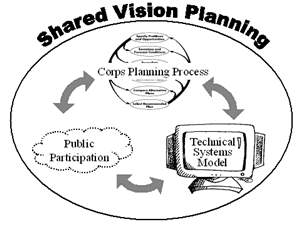Q. How did Shared Vision Planning come about?
A. Shared Vision Planning traces its roots to water supply planning for the Washington, D.C. metropolitan area (see the Case Studies on this site). The approach was more formally developed, tested and refined by IWR during the National Drought Study (1989-1993). IWR has applied Shared Vision Planning in various water conflicts since then. See the Shared Vision Planning History for more information.
Q. Can I hire IWR to do Shared Vision Planning for my problem?
A. That has been done, but it is better if those involved in the regional issues learn to do it themselves. That is precisely why we developed this web site, for those involved to learn to do Shared Vision Planning. However, please do not hesitate to contact us if you have unanswered questions or issues. This will not only help you but also help us ensure the website is providing the best and most helpful information possible.
Q. What is Shared Vision Planning?
A. Shared vision planning is a planning process that incorporates collaboration, sound technical analysis, and tried and true planning principles into a practical forum in which resource management decisions are made. The approach integrates in a unique way three components of a typical planning study: 1) The Corps Planning Process, 2) Public Participation, and 3) Computer Modeling.
See this paper by Kurt Stephenson for more information.
Q. What is the purpose of Shared Vision Planning and why is it helpful?
A. Shared Vision Planning is an approach specifically designed to address difficult conflicts between stakeholders within a complex water management problem. The essence of Shared Vision Planning is to create a planning process capable of building a mutual understanding of the facts involved in a problem for the ultimate purpose of focusing decision-participants' attention, debate, and resolution on values.
Q. When should Shared Vision Planning be used?
A. Shared Vision Planning can be helpful in a number of situations, but some problems are not appropriate for this approach. To help decide whether Shared Vision Planning is right for a particular situation, read this short paper by Bill Werick and Rick Palmer, the pioneers of Shared Vision Planning. Pay special attention to the five questions posed near the end of the paper.
Paper (pdf, 651 KB)
Q. Do I have to collaboratively develop an integrated model to do Shared Vision Planning?
A. Shared Vision Planning is intended for situations in which there is conflict. Where there is conflict there is usually disagreement over the facts and mistrust between different experts and stakeholders. Building a model collaboratively is a virtual requirement for addressing these issues and is a central aspect of Shared Vision Planning. However, if good, trusted modeling already exists, you may not have to build a new model, and instead use the existing model collaboratively within the planning processes to develop and evaluate alternatives. If you aren't building an integrated, transparent model, then you're technically not doing Shared Vision Planning, but if you're collaboratively using a model to solve water problems, then you're probably doing a pretty good job regardless.
Q. Does Shared Vision Planning only apply to water resources issues?
A. Not necessarily. IWR and others involved with this approach have only applied it to water problems. The nature of the Corps planning process is specifically designed for water management problems. However, a planning process suitable for other types of natural resources problems (e.g., forest management) could be addressed using Shared Vision Planning using models and a public participation process that are appropriate for that problem. Other researchers and practitioners have applied approaches similar to Shared Vision Planning to other types of problems (e.g., see the book Mediated Modeling by Marjan van den Belt).
Q. What software has been used to develop Shared Vision Planning models?
A. IWR has relied mostly on STELLA® simulation software combined with Microsoft Excel for data inputs and outputs, and more recently we have used Microsoft Excel® for simulation as well as input-output. Other software packages can be used. Our colleagues at Sandia National Lab use PowerSim® which offers capabilities similar to STELLA®. Our colleagues at Hyrologics use OASIS® in a collaborative setting, and IWR is investigating the use of software packages specific to water that could also be used (e.g. HEC-ResSim®).
Q. Does using Shared Vision Planning guarantee an acceptable outcome amongst all stakeholders?
A. Definitely not, but it might be the best approach for building potential consensus. Because of all reasons discussed above and on other pages on this web site, Shared Vision Planning will help stakeholders reach agreement on the facts and have an effective dialogue about their preferences and values. The process will also help planners formulate alternatives that better meet the objectives of the stakeholders. The benefits make consensus more likely, but they cannot guarantee it because sometimes there are value differences that cannot be resolved. In those cases, agency decision-makers are left with making a tough choice. But at least the Shared Vision Planning process can provide them with detailed information on objectives, impacts and preferences. This should help decision-makers to produce a quality, informed decision.
Q. Who do I contact if I want more information about using the Shared Vision Planning approach?
A. Hal Cardwell (703) 428 – 9071 Hal.E.Cardwell@usace.army.mil